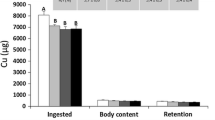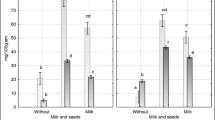Abstract
Background
Maillard reaction products (MRP) improve food palatability and are linked to some positive biological actions. However, diverse negative consequences, some related to protein damage and mineral availability, have been established.
Aim of study
We investigated the effects of MRP, from a bread crust diet, on phosphorus bioavailability and tissue distribution in rats to determine whether these effects are related to the molecular weight of browning products.
Methods
During a study period of 88 days, rats were fed either a control diet or one of the following: with bread crust as a source of MRP, or one with its soluble high molecular weight, soluble low molecular weight or insoluble fraction (bread crust, HMW, LMW and insoluble diets, respectively). In the final week, a phosphorus balance was performed, after which the animals were sacrificed and some organs removed to analyse phosphorus content. A second balance was carried out throughout the experimental period to calculate phosphorus retention.
Results
Phosphorus balance in the last week was unchanged. However, considering the whole experimental period, a trend towards improved bioavailability, significant in the HMW group, was observed. Higher phosphorus concentrations were measured in the small intestine and bone.
Conclusions
The consumption of MRP derived from bread did not alter phosphorus retention, due to increased bioavailability, especially concerning HMW compounds. The overall phosphorus body content remained unchanged and there were no changes in the bone, its principal metabolic destination. However, MRP consumption markedly raised phosphorus levels at the digestive level, especially when consumed as isolate fractions. The slower rate of stomach emptying is assumed to be related to this effect.


Similar content being viewed by others
References
Ames JM (1998) Applications of the Maillard reaction in the food industry. Food Chem 62:431–439
Jaeger H, Janositz A, Knorr D (2010) The Maillard reaction and its control during food processing. The potential of emerging technologies. Pathol Biol 58:207–213
Prättälä RH, Helasoja V, Mykkänen H (2001) The consumption of rye bread and white bread as dimensions of health lifestyles in Finland. Public Health Nutr 4:7
Siega-Riz AM, Poplin BM, Carson T (2000) Differences in food patterns at breakfast by sociodemographic characteristics among a nationally representative sample of adults in the United States. Prev Med 30:415–424
Somoza V (2005) Five years of research on health risks and benefits of Maillard reaction products: an update. Mol Nutr Food Res 49:663–672
Delgado-Andrade C, Morales FJ (2005) Unravelling the contribution of melanoidins to the antioxidant activity of coffee brews. J Agric Food Chem 53:1403–1407
Marko D, Habermeyer M, Kemény M, Weyand U, Niederberger E, Frank O, Hofmann T (2003) Maillard reaction products modulating the growth of human tumor cells in vitro. Chem Res Toxicol 16:48–55
Wagner KH, Reichhold S, Koschutnig K, Chériot S, Billaud C (2007) The potential antimutagenic and antioxidant effects of Maillard reaction products used as “natural antibrowning” agents. Mol Nutr Food Res 51:496–504
Seiquer I, Díaz-Alguacil J, Delgado-Andrade C, López-Frías M, Muñoz Hoyos A, Galdó G, Navarro MP (2006) Diets rich in Maillard reaction products affect protein digestibility in adolescent males aged 11–14 y. Am J Clin Nutr 83:1082–1088
Navarro MP (2003) Impact of Maillard reaction products on mineral bioavailability. In: Vaquero MP, García-Arias T, Carbajal A, Sánchez-Múniz FJ (eds) Bioavailability of micronutrients and minor dietary compounds. Metabolic and technological aspects. Research Signpost, Kerala, pp 133–145
Rendleman JA (1987) Complexation of calcium by the melanoidin and its role in determining bioavailability. J Food Sci 52:1699–1705
O’Brien J, Morrissey PA (1997) Metal ion complexation by products of the Maillard reaction. Food Chem 58:17–27
Delgado-Andrade C, Seiquer I, Nieto R, Navarro MP (2004) Effects of heated glucose-lysine and glucose-methionine model systems on mineral solubility. Food Chem 87:329–337
Morales FJ, Fernández-Fraguas C, Jiménez-Pérez S (2005) Iron-binding ability of melanoidins from food and model systems. Food Chem 90:821–827
Andrieux C, Sacquet E (1984) Effects of Maillard’s reaction products on apparent mineral absorption in different parts of the digestive tract. The role of microflora. Reprod Nutr Develop 23:379–386
Knochel JP (1999) Phosphorus. In: Shils ME, Olson JA, Shike M, Catharine Ross A (eds) Modern nutrition in health and disease, 9th edn. Lippincott Williams & Wilkins, Pensylvania, pp 157–167
Drezner MK (2008) Phosphorus homeostasis and related disorders. In: Bilezikian JO, Raisz LG, Rodan RA (eds) Principles of bone biology, 3rd edn. Academic Press, San Diego, pp 465–486
Delgado-Andrade C, Seiquer I, Mesías García M, Galdó G, Navarro MP (2011) Increased intake of Maillard reaction products reduces phosphorus digestibility in male adolescents. Nutrition 27:86–91
Delgado-Andrade C, Rufián-Henares JA, Morales FJ (2008) Optimised procedure to analyse Maillard reaction-related fluorescence in cereal-based products. Czech J Food Sci 26:339–346
Reeves PG, Nielsen FH, Fahey GC (1993) AIN-93 purified diets for laboratory rodents: final report of the American Institute of Nutrition Ad Hoc Writing Committee on the reformulation of the AIN-76A rodent diet. J Nutr 123:1939–1951
AOAC (1980) In: Horwitz W (ed) Official methods of analysis, 13th edn. Association of Official Analytical Chemists, Washington, DC
Delgado-Andrade C, Seiquer I, Haro A, Castellano R, Navarro MP (2010) Development of the Maillard reaction in foods cooked by different techniques. Intake of Maillard-derived compounds. Food Chem 122:145–153
Seiquer I, Aspe T, Vaquero P, Navarro P (2001) Effects of heat treatment of casein in the presence of reducing sugars on calcium bioavailability: in vitro and in vivo assays. J Agric Food Chem 49:1049–1055
Delgado-Andrade C, Seiquer I, Navarro MP (2002) Copper metabolism in rats fed diets containing Maillard reaction products. J Food Sci 67:855–860
Mesías M, Seiquer I, Delgado-Andrade C, Galdó G, Navarro MP (2009) Intake of Maillard reaction products reduces iron bioavailability in male adolescents. Mol Nutr Food Res 53:1–10
Furniss DE, Vuichoud J, Finot PA, Hurrell RF (1989) The effect of Maillard reaction products on zinc metabolism in the rat. Br J Nutr 62:739–749
Sarriá B, López-Fandino R, Vaquero MP (2001) Does processing of a powder or in-bottle-sterilized liquid infant formula affect calcium bioavailability? Nutrition 17:326–331
Delgado-Andrade C (2002) Reacción de Maillard: Influencia sobre la biodisponibilidad mineral. Doctoral thesis, Granada, Spain
Abu-Dweih BM, Tukan SK, Takruri HR (2000) The effect of browning intensity on the protein quality of qurshallah. Int J Food Sci Nutr 6:483–488
Andrieux E, Sacquet E, Guéguen L (1980) Interactions between Maillard reaction’s products, the microflora of the digestive tract and mineral metabolism. Reprod Nutr Develop 20(4):1061–1069
Navarro P, Aspe T, Seiquer I (2002) Zinc transport in caco-2 cells and zinc balance in rats: influence of the heat treatment of a casein-glucose-fructose mixture. J Agric Food Chem 48:3589–3596
Finot PA (2003) Toxicology of nonenzymatic browning. In: Caballero BC, Trugo LC, Finglas PM (eds) Encyclopedia of food sciences and nutrition, 2nd edn. Academic Press, London, pp 673–678
Friedman M (1996) Food browning and its prevention: an overview. J Agric Food Chem 44:631–653
Somoza V, Lindenmeier M, Hofmann T, Frank O, Erbersdobler HF, Baynes JW et al (2005) Dietary bread crust advanced glycation end products bind to the receptor for AGEs in HEK-293 kidney cells but are rapidly excreted after oral administration to healthy and subtotally nephrectomized rats. Ann NY Acad Sci 1043:492–500
Kutchai HC (1998) Gastrointestinal secretion. In: Berne RM, Levy MN, Koeppen BM, Stanton BA (eds) Physiology, 4th edn. Mosby Inc., St. Louis, pp 617–646
Rèrat A, Calmes R, Vaissade P, Finot PA (2002) Nutritional and metabolic consequences of the early Maillard reaction of heat treated milk in the pig, significance for man. Eur J Nutr 41:1–11
Kimiagar M, Lee TC, Chichester CO (1980) Long-term feeding effects of browned egg albumin to rats. J Agric Food Chem 28:150–155
Somoza V, Wenzel E, Lindenmeier M, Grothe D, Erbersdobler HF, Hofman T (2005) Influence of feeding malt, bread crust, and a pronylated protein on the activity of chemopreventive enzymes and antioxidative defense parameters in vivo. J Agric Food Chem 53:8176–8182
Bovee-Oudehoven IM, Wissink ML, Wouters JT, Van der Meer R (1999) Dietary calcium phosphate stimulates intestinal Lactobacilli and decreases the severity of a Salmonella infection in rats. J Nutr 129:607–612
Hein GE (2006) Glycation endproducts in osteoporosis—is there a pathophysiologic importance? Clin Chim Acta 371:32–36
Alikhani M, Alikhani Z, Boyd C, MacLellan CM, Raptis M, Liu R, Pischon N, Trackman PC, Gerstenfeld L, Graves DT (2007) Advanced glycation end products stimulate osteoblast apoptosis via the MAP kinase and cytosolic apoptotic pathways. Bone 40:345–353
Kawashima Y, Fritton JC, Yakar S, Epstein S, Schaffler MB, Jepsen KJ, LeRoith D (2009) Type 2 diabetic mice demonstrate slender long bones with increased fragility secondary to increased osteoclastogenesis. Bone 44:648–665
Acknowledgments
This work was supported by a project of the Spanish Ministry of Science and Innovation. The authors thank Grupo Siro, a Spanish manufacturer of cereal-derived food products, for supplying the bread crust samples.
Conflict of interest
The authors declare there is no conflict of interest.
Author information
Authors and Affiliations
Corresponding author
Rights and permissions
About this article
Cite this article
Roncero-Ramos, I., Delgado-Andrade, C., Alonso-Olalla, R. et al. Influence of bread crust-derived Maillard reaction products on phosphorus balance in rats. Eur J Nutr 51, 871–879 (2012). https://doi.org/10.1007/s00394-011-0267-3
Received:
Accepted:
Published:
Issue Date:
DOI: https://doi.org/10.1007/s00394-011-0267-3




